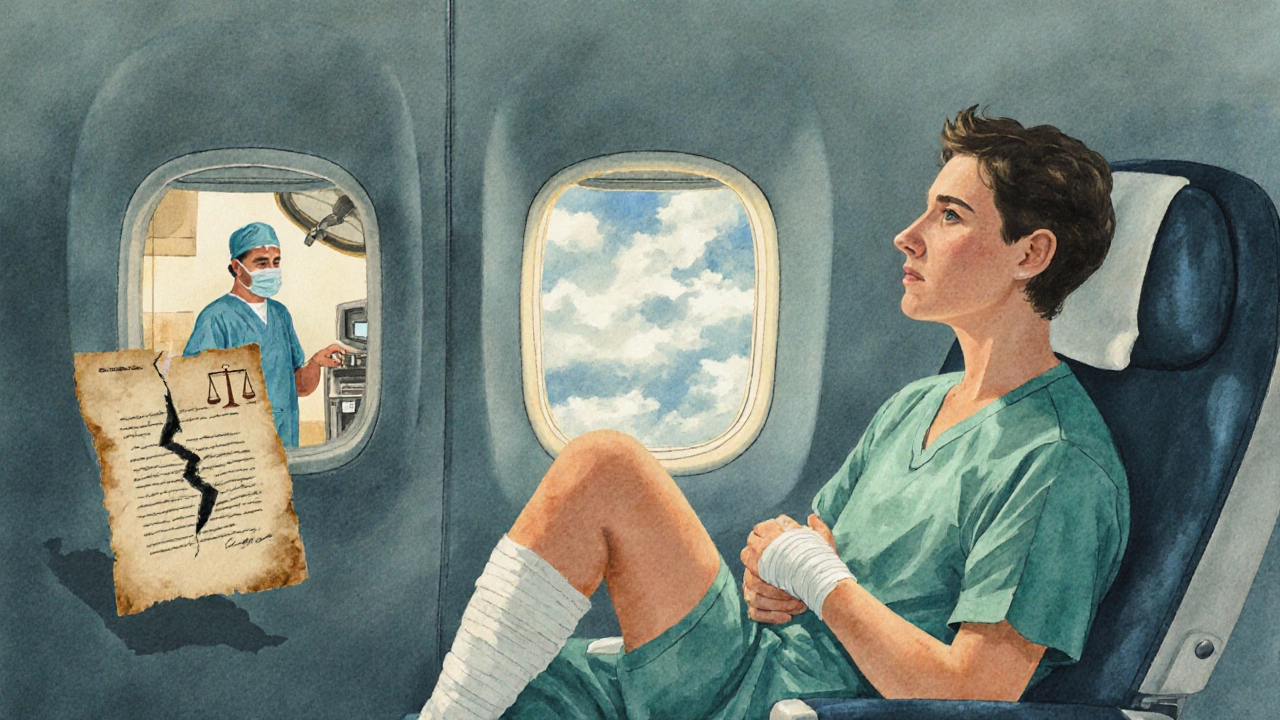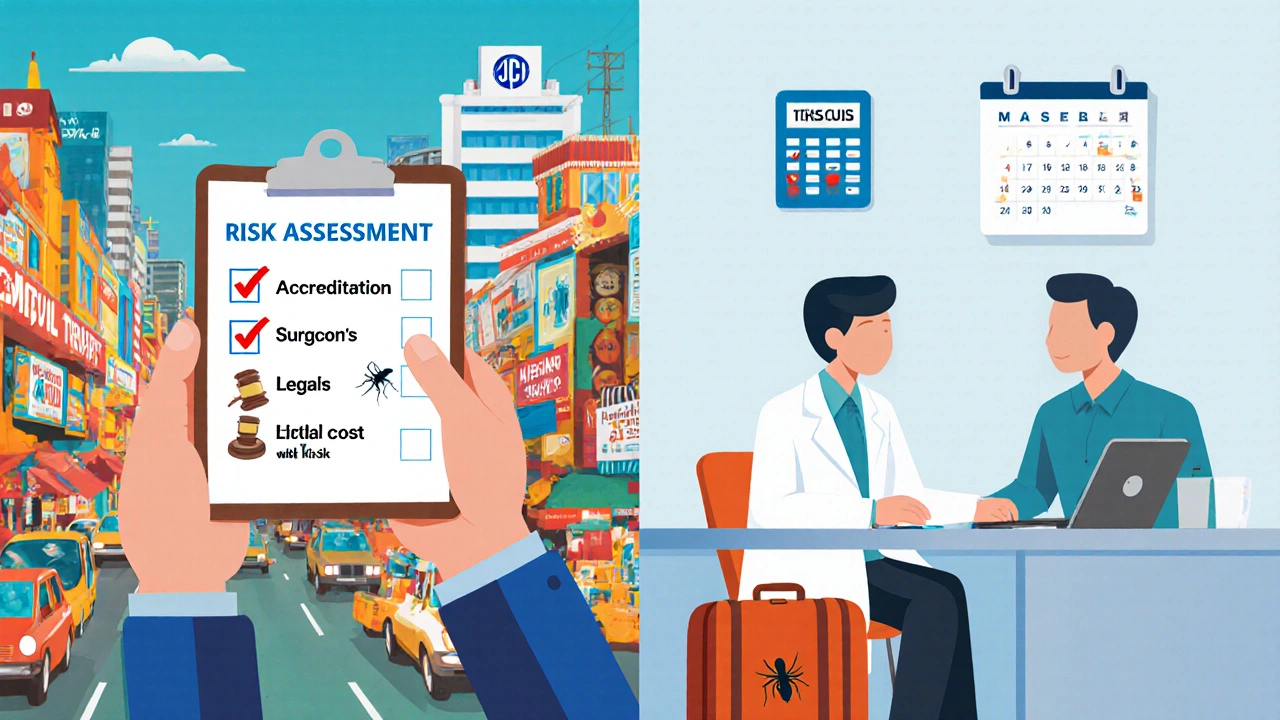Medical Tourism Risk Calculator
This tool helps you evaluate the potential risks associated with medical tourism based on your specific situation. Input your details below to receive a personalized risk assessment and recommendations.
Quick Summary
- Procedures abroad may lack consistent quality standards, raising patient safety concerns.
- Legal recourse is limited when complications arise overseas.
- Follow‑up care is often fragmented, leading to higher long‑term costs.
- Travel, language and cultural barriers can turn a simple treatment into a stressful ordeal.
- Hidden expenses and insurance gaps may erase any upfront savings.
People chase cheaper procedures, shorter wait lists, or exotic locations, but cons of medical tourism can outweigh the allure. Below we break down the most common pitfalls so you can decide whether crossing borders for health care is worth the risk.
Medical tourism is a travel‑based health‑care model where patients leave their home country to receive medical treatment abroad. It includes everything from cosmetic surgery in Bangkok to cardiac interventions in India. While the concept sounds appealing, several hidden challenges often surface once you step off the plane.
Quality and Safety Concerns
Patient safety refers to preventing avoidable harm during care is the backbone of any medical procedure. In many popular destinations, hospital accreditation systems differ from those in the U.S. or Europe. Even when a clinic advertises JCI (Joint Commission International) accreditation, the depth of onsite audits can vary.
Without universally enforced standards, you risk:
- Outdated equipment that fails to meet the latest safety guidelines.
- Surgeons with limited experience in the specific technique you need.
- Inconsistent infection‑control protocols, leading to higher postoperative infection rates.
One 2022 analysis of 15,000 procedures performed in three South‑Asian hubs found a 12% higher complication rate compared with equivalent surgeries in accredited U.S. centers. The gap narrowed when facilities had full Accreditation formal recognition of meeting international health‑care standards from recognized bodies.
Legal and Regulatory Risks
When something goes wrong, Legal jurisdiction the court system that governs disputes becomes a maze. Most countries where medical tourism flourishes have limited tort law, meaning you may not be able to sue for malpractice or receive compensation comparable to your home country.
Key legal pitfalls include:
- Difficulty enforcing contracts after you return home.
- Limited access to the original medical records for follow‑up litigation.
- Insurance policies that exclude foreign‑treatment complications.
In 2021, a UK patient who suffered a failed hip replacement in Turkey faced a €10,000 legal fee just to obtain the surgeon’s notes, without any guarantee of a settlement.
Follow‑up Care and Continuity Issues
Follow‑up care post‑procedure monitoring and rehabilitation is essential for a smooth recovery. When you’re thousands of miles away, arranging timely check‑ups becomes a logistical nightmare.
Potential scenarios:
- Complications appear after you’ve flown back, but the foreign surgeon isn’t reachable.
- Your local doctor is unfamiliar with the technique used abroad, leading to misdiagnosis.
- Re‑operations required abroad incur additional travel and accommodation costs.
According to a 2023 survey of 1,200 US medical tourists, 38% reported needing at least one unexpected follow‑up visit back in the destination country.

Hidden Costs and Financial Surprises
At first glance, the price tag of, say, a $3,500 spine surgery in Mexico looks like a steal compared with a $15,000 US quote. Yet many hidden expenses erode the savings:
- International airfare and visa fees.
- Private airport transfers, especially if emergency transport is needed.
- Extended hospital stays due to post‑op monitoring.
- Out‑of‑pocket medication not covered by home‑country insurance.
- Potential loss of income during recovery.
One traveler recounted spending an extra $2,200 on a post‑surgery infection that required a week‑long stay in a private ward.
Travel‑Related Health Risks
Long flights, jet lag, and climate changes can affect your body’s ability to heal. Deep‑vein thrombosis (DVT) is a known risk for patients who sit for extended periods during international travel.
Other travel‑related concerns include:
- Exposure to regional diseases (e.g., dengue, malaria) if proper prophylaxis isn’t taken.
- Limited access to emergency services during travel delays.
- Physical strain from luggage handling, which can aggravate recent surgeries.
Cultural & Communication Barriers
Cultural barrier differences in language, customs, and expectations between patient and provider can lead to misunderstandings about consent, medication schedules, or post‑op instructions.
Examples:
- Misinterpretation of dosage instructions because of translation errors.
- Different attitudes toward pain management, causing under‑ or over‑medication.
- Discomfort discussing sensitive health topics with providers from different cultural backgrounds.
Such gaps often result in non‑compliance, which can jeopardize recovery.

Ethical and Reputation Concerns
Some destinations have been criticized for lax regulation of organ transplantation, stem‑cell therapies, or unproven “miracle cures.” Engaging with providers that operate in gray areas may expose you to:
- Procedures lacking robust clinical evidence.
- Exploitation of vulnerable patients.
- Potential legal repercussions if the treatment violates home‑country medical regulations.
Before booking, verify that the clinic adheres to ethical standards recognized by international bodies such as the World Health Organization.
Risk‑Assessment Checklist
Use this quick list to gauge whether a medical‑tourism plan is worth the gamble:
- Confirm the clinic holds reputable Accreditation (e.g., JCI, ISO 9001).
- Research the surgeon’s credentials, experience, and patient outcomes.
- Understand the legal recourse in the destination country.
- Plan for post‑procedure follow‑up, either locally or through a tele‑medicine link.
- Calculate total cost, including travel, accommodation, and potential extra medical fees.
- Check travel‑related health advisories and arrange necessary vaccinations or prophylaxis.
- Verify language support and clear communication channels.
- Assess ethical compliance of the treatment and the facility.
If any item raises a red flag, consider postponing or seeking care at home.
Comparison: Medical Tourism vs. Local Treatment
| Aspect | Medical Tourism | Local Treatment |
|---|---|---|
| Cost (procedure only) | 30‑70% lower | Full market rate |
| Quality Control | Varies; depends on accreditation | Standardized, regulated |
| Legal Recourse | Limited, jurisdictional challenges | Clear, domestic legal framework |
| Follow‑up Care | Often fragmented across borders | Integrated with your primary physician |
| Travel Risks | Yes - DVT, infection, jet lag | None (unless you travel for care) |
Frequently Asked Questions
Can I use my health insurance for abroad procedures?
Most domestic plans treat overseas care as out‑of‑network, covering only emergency services. Some premium policies offer limited reimbursements, but you’ll often need to pay upfront and claim later.
How do I verify a clinic’s accreditation?
Visit the accrediting body’s official website (e.g., JCI, NABH) and search for the facility’s name. Look for the latest audit date and scope of services covered.
What should I do if complications arise after returning home?
Seek immediate care from a local physician and request the original operative notes. Contact the foreign provider for clarification, but be prepared for possible delays and additional charges.
Is it safer to travel for elective surgery during a pandemic?
Risk levels vary by country and vaccination status. Check WHO travel advisories, ensure the facility follows strict infection‑control protocols, and consider the added stress of quarantine on recovery.
Do language barriers affect post‑operative instructions?
Absolutely. Misunderstandings about medication dosage or wound care can cause complications. Insist on written instructions in your native language or use a certified medical translator.





